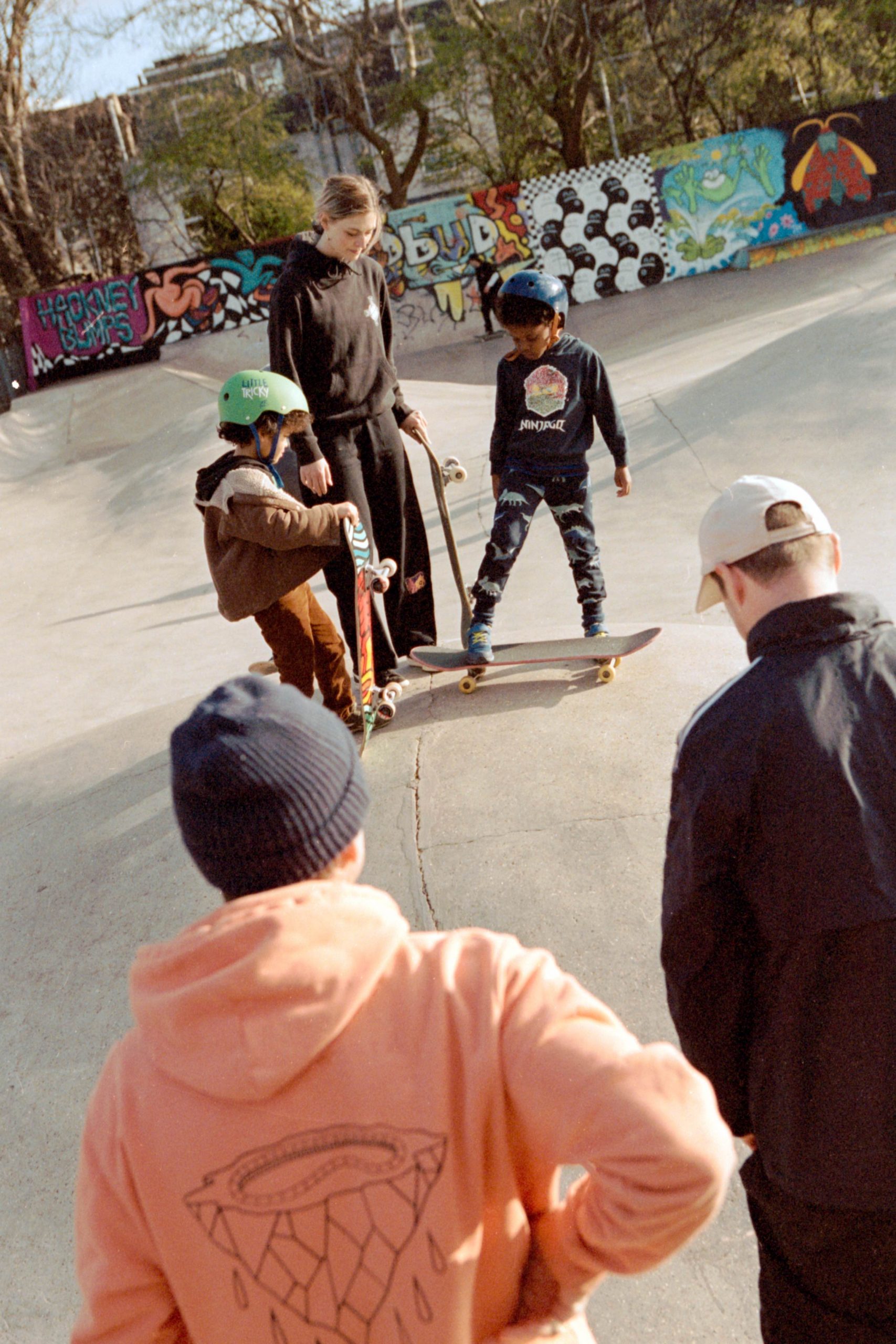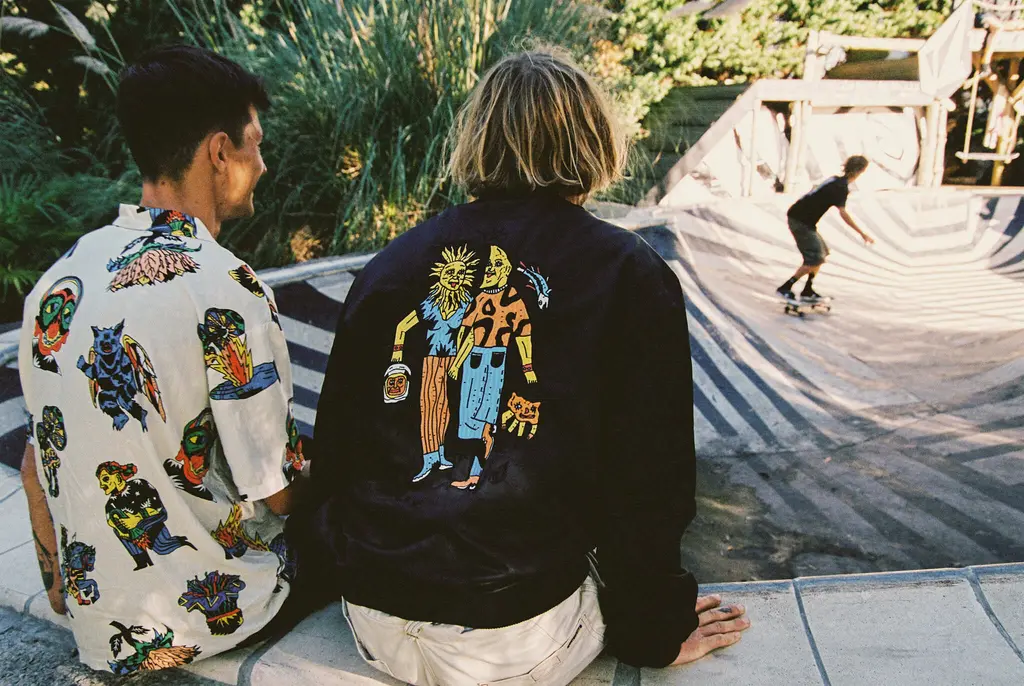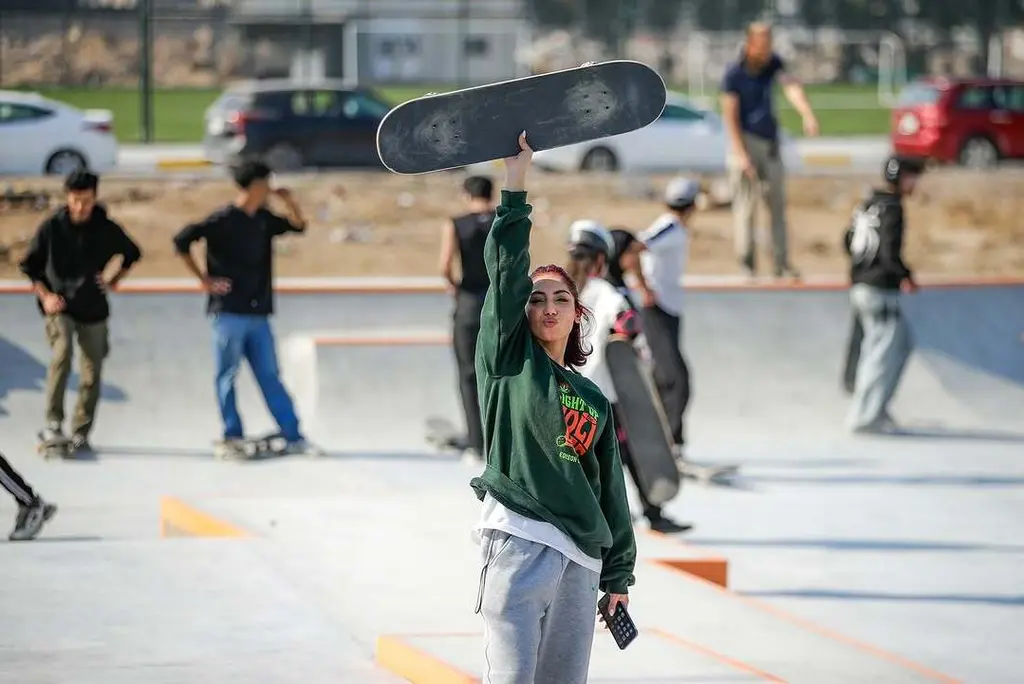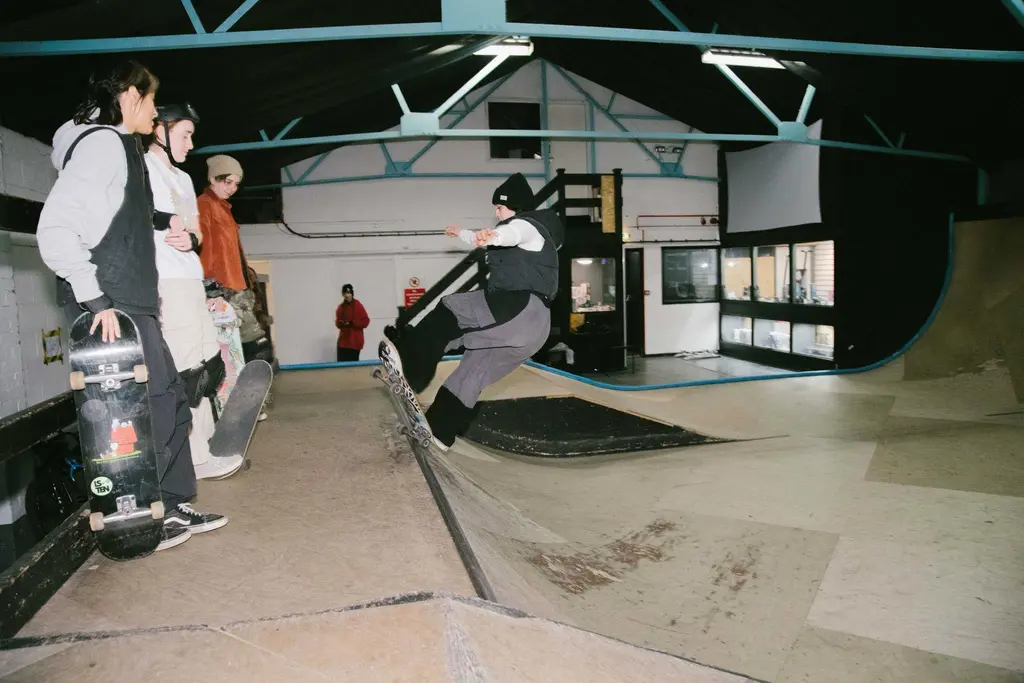The concrete haven where skateboarding is just the start
- Text by Jessica Holland
- Photography by Greg Holland

A version of this story appears in Huck Issue 77. Get your copy now, or subscribe to make sure you never miss another issue.
What’s better than this? It’s a summer night and you’re 15 years old. You’re playing spin the bottle with your friends at Hackney Bumps, a skate park made of undulating concrete that looks like a lunar landscape, stretching out into the darkness. The bottle lands on your crush, and your mate says she should kiss you. You give them a panicked look, but the girl says, “Fuck it, why not?”
The person telling me this story is Elijah McKenzie, who’s 16 now, goes by the name Moss, and uses he/they pronouns. We’re talking about what Bumps – a decades-old BMX spot, originally, that was given new life by a small group of skateboarders during the pandemic – means to him. This is one moment that comes to mind. The kiss, by the way: “I can’t even describe it. It felt like serenity.”
Another image that stands out is of him sitting out on the warm concrete with friends, blasting music and watching the sky turn ice-cream colours. The loose-limbed feeling of having spent the day in motion, sweat on his skin, sun in his eyes, trying skate tricks, hitting the floor, scrapes and bruises, the euphoria of landing something new. “Last summer was the best summer of my life,” he says. “If Bumps wasn’t here, it wouldn’t have been anything like how it was. It would have been glum.”
 Moss needed somewhere like this. They moved to this part of East London, across the river from the Olympic Park, at the start of the pandemic when they went into foster care, aged 14. Their home life had been difficult and chaotic for some time. They’d witnessed violence and the effects of addiction, and had been trying to hold things together for their mum and five siblings, three of whom are autistic. Then they uncovered a secret that made them feel that their efforts were pointless, that no one else in a position of responsibility was even trying. “That was the breaking point. I was the most angry I’ve ever been.”
Moss needed somewhere like this. They moved to this part of East London, across the river from the Olympic Park, at the start of the pandemic when they went into foster care, aged 14. Their home life had been difficult and chaotic for some time. They’d witnessed violence and the effects of addiction, and had been trying to hold things together for their mum and five siblings, three of whom are autistic. Then they uncovered a secret that made them feel that their efforts were pointless, that no one else in a position of responsibility was even trying. “That was the breaking point. I was the most angry I’ve ever been.”
They packed a bag, went to school, and told a teacher they weren’t going back. At 8pm that night, a social worker took them from school to an emergency foster home, which has since become permanent. “It was the first good environment I’ve ever been in,” they say. “It did wonders for me. But I was never going to heal just from being somewhere new.”
School wasn’t the place where that healing was going to happen either – even though Moss is a decent student, with places at two music colleges for next year. “I don’t want to sound like a 2000s emo kid, but I just don’t fit in there. As soon as I go in there, my mindset is just negative.”
 Spring 2021, a year into foster care, was the “darkest time” in Moss’ life. “I was dealing with a lot of intrusive and horrible thoughts. That’s when I started skating.” He’d had a little Penny board since he was eight and would play Skate 3 on XBox, but it was walking past Hackney Bumps – “seeing all these people having fun, doing cool shit” – that inspired him to get a full-size skateboard.
Spring 2021, a year into foster care, was the “darkest time” in Moss’ life. “I was dealing with a lot of intrusive and horrible thoughts. That’s when I started skating.” He’d had a little Penny board since he was eight and would play Skate 3 on XBox, but it was walking past Hackney Bumps – “seeing all these people having fun, doing cool shit” – that inspired him to get a full-size skateboard.
On his first day skating, he met another teenager at the park. She introduced him to her group of friends a couple of days later. “They just kind of adopted me. I remember sitting on that green bench over there, looking at my new friends around me, and tearing up a bit. Like, ‘Shit, I’m part of something now. We’re not just people who sit around and do nothing.’ It was perfect.”
Since then, Moss says, skating has probably changed “every single thing” about them. “It helped me find my people and find a good, healthy coping mechanism for once. I could tire myself out, get mad from not landing a trick, be ecstatic from landing one. It distracts me for hours on end. I’m not saying that skating’s going to fix your life, but if I’m feeling [like] I’m about to do something really shitty to myself, I’ll go and skate.”
 When Moss first moved to this part of Lower Clapton, in early March 2020, Bumps wasn’t necessarily the kind of place that would inspire big life changes. Built in 1986, it hadn’t been resurfaced as far back as anyone could remember, and was crusty enough to take off a layer of skin if you fell. The odd BMXer or skater would pop by, but it was mostly empty and forgotten, occupying a corner of a flat, featureless park surrounded by low-rise council housing.
When Moss first moved to this part of Lower Clapton, in early March 2020, Bumps wasn’t necessarily the kind of place that would inspire big life changes. Built in 1986, it hadn’t been resurfaced as far back as anyone could remember, and was crusty enough to take off a layer of skin if you fell. The odd BMXer or skater would pop by, but it was mostly empty and forgotten, occupying a corner of a flat, featureless park surrounded by low-rise council housing.
Two local skaters could see its potential, though. Greg King and Nick Tombs had met through their work in film and TV lighting in 2018 and started skating at Bumps (or Humps, as some locals still know it) on weekends. Greg had previously helped out with the campaign to save the DIY skate spot at London’s Southbank Centre from destruction, which had sparked a wider conversation about the social value of skate parks and the importance of preserving them.
Greg was in his late 30s at the time, and had been a skateboarder since the ’90s. Nick was just turning 30, and had only recently fallen in love with skating, thanks to the backyard mini he’d built with housemates in Leyton, where he’d skate at dawn after nights out. Now both living in Homerton, the two of them started meeting regularly for a skate at Bumps, and kept having the same conversation about how someone should sort the place out. Then one day, Greg said: “It should be us.”
 Nick’s response, he says, was immediate. “My whole life, I never felt something with so much conviction straight off the bat. I’d never done any of this shit before, but straight away, I was like, ‘Yeah. We’re going to do this.’”
Nick’s response, he says, was immediate. “My whole life, I never felt something with so much conviction straight off the bat. I’d never done any of this shit before, but straight away, I was like, ‘Yeah. We’re going to do this.’”
The two skaters organised a café meet-up to bounce ideas off other locals. Daryl Nobbs, founding member of skate-park construction company Betongpark, turned up and threw himself into the project, dreaming up designs and working on proposals for the council, who seemed to be on board with the idea. The neighbourhood had high levels of illness due to inactivity, and Sport England had allocated funding to change that. In mid-2019, the skaters secured a small grant to put on free kids’ skate lessons and a jam.
The most obvious way of sprucing up a skate park is by repouring concrete, but Daryl helped Nick and Greg test out a cheaper resurfacing method, with equipment lent (and eventually bought) from friends in Sweden. It involved grinding off the Bumps’ rough top layer with an abrasive disc: painstaking labour carried out an inch at a time on hands and knees. By March 2020, half of the park had been polished. The next step was to secure funds for a full, professional, council-approved renovation. But when the pandemic hit, all official plans were shelved indefinitely.
 The skaters had already been getting hold of their own materials and working for free, and they decided to keep going without any official help or permission. By April, they had formulated a pandemic routine. Wake up at 8am, roll equipment down to Bumps on a trolley, plug a kettle into a power cord running out of a neighbour’s window, put NTS Radio on. They’d grind all morning, then pick up some beers and skate later on. Other local skaters lent a hand. “We were there every single day for three months,” Nick says. “It rained once. It felt like the perfect time to start this.”
The skaters had already been getting hold of their own materials and working for free, and they decided to keep going without any official help or permission. By April, they had formulated a pandemic routine. Wake up at 8am, roll equipment down to Bumps on a trolley, plug a kettle into a power cord running out of a neighbour’s window, put NTS Radio on. They’d grind all morning, then pick up some beers and skate later on. Other local skaters lent a hand. “We were there every single day for three months,” Nick says. “It rained once. It felt like the perfect time to start this.”
In May 2020, Daryl suggested adding a low concrete quarter-pipe to the edge of the park. Within a week, it was up, built with no power tools or cement mixer, just shovels, hammers, and bits of wood to make the forms. “From there it snowballed,” Daryl says. “It was the perfect storm. The energy re-lit so much stoke in me for what we do.”
Almost all of London’s skate parks were closed that spring: some filled with wood chips to stop people gathering, some regularly patrolled by police. Word got around that Hackney Bumps was not only skateable but that police were leaving it alone. Thrasher posted a video that featured pro skater Jordan Thackeray flying up the new quarter and landing a trick on top of the fence behind, and the news continued to spread.
 You can see this phase unfolding in Bumps and Grind, a 20-minute documentary by skater and filmmaker Henry Edwards-Wood. One night in June 2020, the film was screened at the skate park itself, beamed from a projector balanced on a wooden ramp onto the back wall. It was warm enough to sit out in t-shirts and shorts, and hundreds came to watch, hungry to be together after months of isolation.
You can see this phase unfolding in Bumps and Grind, a 20-minute documentary by skater and filmmaker Henry Edwards-Wood. One night in June 2020, the film was screened at the skate park itself, beamed from a projector balanced on a wooden ramp onto the back wall. It was warm enough to sit out in t-shirts and shorts, and hundreds came to watch, hungry to be together after months of isolation.
“I cried a little bit,” says Kaitlene Koranteng, who grew up within walking distance of the Bumps and skates there regularly. “Even when it got pitch-black, there were still people there and music playing. It turned into a massive party. It was the best vibe.”
By the time Moss started skating there the following spring, the council had stopped talking about knocking the new features down. Ledges, banks and quarter-pipes now lined two sides of the park. A second and third resurfacing pass had been completed with finer-grained polishing discs, and brands like Dickies and Vans had donated merch and money to supplement funds generated from selling t-shirts. The place had become “an iconic spot in London,” as Jordan Thackeray puts it. “Always sunny at Bumps, innit.”
 This wasn’t the first skate park Moss had been to. They’d taken their Penny board to Lloyd Park in Walthamstow when they lived that way, but they never clicked with it. “People are mean there. They’ll literally olly over you if you fall. It feels very robotic and fake. Lloyds is the skeleton, and Bumps is the organs, basically.”
This wasn’t the first skate park Moss had been to. They’d taken their Penny board to Lloyd Park in Walthamstow when they lived that way, but they never clicked with it. “People are mean there. They’ll literally olly over you if you fall. It feels very robotic and fake. Lloyds is the skeleton, and Bumps is the organs, basically.”
It wasn’t an accident, the fact that people can show up at Bumps and feel at home. “From the very beginning, we wanted it to be a park that was quite welcoming,” says Greg. “Sometimes skate parks aren’t, especially for beginners, sometimes for female skaters. The idea was to make a space where some little kid can come on a scooter, and they’re entitled to use the place as well.”
The inclusivity goes beyond the painted sign that reads ‘This is a space for everyone’ at the entrance. Nick and Greg have knocked on a few thousand doors, by Greg’s estimation, to spread the word about the free skate lessons they’ve been holding periodically since 2019. Locals often pass down old setups to kids who want to start skating.
 Twyla Lidén, another skater who credits Bumps for getting her on a board, organised a jam there for women and non-binary skaters in 2021, with a poetry reading and boob-shaped cupcakes. “What other skate park does that?” Moss asks. “I love it here. I’m never alone, unless the park’s empty. I’ve always got someone to talk to.”
Twyla Lidén, another skater who credits Bumps for getting her on a board, organised a jam there for women and non-binary skaters in 2021, with a poetry reading and boob-shaped cupcakes. “What other skate park does that?” Moss asks. “I love it here. I’m never alone, unless the park’s empty. I’ve always got someone to talk to.”
That’s not to say that the park can’t get “kind of seshy,” as Kaitlene puts it, when experienced skaters are going hard and hyping each other on. But care has been taken to think about everyone else. Last time the skaters added a new feature to the park, the community was invited to submit designs, with votes cast for shortlisted entries. Next, Nick and Greg hope to add a water fountain, bike racks and a “baby bumps” section out the front, to give inexperienced skaters somewhere safe to learn.
“It’s helped me to re-evaluate what I care about,” says Tom Lock, who credits Hackney Bumps with rekindling his love of skating after a decade-long break.
For Nick Tombs, who’s played such a key role in the regeneration: “It has been the only thing I’ve ever done that I give a fuck about; that I’m proud of. I genuinely can’t imagine what life would be like without it. I’m so fucking grateful for how this whole thing has panned out.”
 A lot of people have had their paths altered by this ambitious project to turn some crusty concrete into a place where community can form. But it’s Moss I get deep into conversation with on a cold day at Bumps in 2022: grey skies, a few people criss-crossing the skate park, lost in their own worlds.
A lot of people have had their paths altered by this ambitious project to turn some crusty concrete into a place where community can form. But it’s Moss I get deep into conversation with on a cold day at Bumps in 2022: grey skies, a few people criss-crossing the skate park, lost in their own worlds.
As we’re talking, a younger kid comes up to ask for wax and Moss rubs the deck of his scooter with a candle, telling him to be careful. Earlier, I’d said to Moss that it was surprising he didn’t turn out a colder, harder person, given everything he’s been through. I’m reminded of his response: “I’ve always wanted to be kind to people, as best as I could. No one knows when you need it the most.”
It’s not one of those days at Bumps where everyone’s shirtless and sun-drenched, sprawled out on the floor when they’re not skating. The place is emptier than usual and we’re shivering after an hour sitting still, but Moss is hyped. A skater he admires complimented his progress, which meant a lot, although he brushed it off casually. This morning he landed his first tre flip, one of those tricks you have to mess up thousands of times until it clicks into place.
“That was a beautiful moment,” he says, before getting back on his board, to lose himself again in repetitive, intricate motion. “It’s probably the one trick that I’ve always wanted to get, my favourite trick ever, and I landed it. Now I’m beaming, man. I’m so happy.”
 Get your copy of Huck 77 now, or subscribe to make sure you never miss another issue.
Get your copy of Huck 77 now, or subscribe to make sure you never miss another issue.
Follow Jessica Holland on Twitter.
Greg Holland is currently working on a photo book documenting the Hackney Bumps community over the past two years.
Enjoyed this article? Follow Huck on Twitter and Instagram.
You might like

At Belgium’s Horst, electronic music, skate and community collide
More than a festival — With art exhibitions, youth projects and a brand new skatepark, the Vilvoorde-Brussels weekender is demonstrating how music events can have an impact all year round.
Written by: Isaac Muk

Volcom teams up with Bob Mollema for the latest in its Featured Artist Series
True to This — The boardsports lifestyle brand will host an art show in Biarritz to celebrate the Dutch illustrators’ second capsule collection.
Written by: Huck

In Baghdad, skater girls are reshaping Iraqi womanhood
Baghdad is rad — As the city’s first skatepark opens, the new space is providing a blank canvas for its board culture. Dalia Dawood speaks to the people looking to make its ramps and rails a safe haven for women and girls.
Written by: Dalia Dawood

In England’s rural north, skateboarding is femme
Zine scene — A new project from visual artist Juliet Klottrup, ‘Skate Like a Lass’, spotlights the FLINTA+ collectives who are redefining what it means to be a skater.
Written by: Zahra Onsori

Is the UK ready for a Kabaddi boom?
Kabaddi, Kabaddi, Kabaddi — Watched by over 280 million in India, the breathless contact sport has repeatedly tried to grip British viewers. Ahead of the Kabaddi World Cup being held in Wolverhampton this month, Kyle MacNeill speaks to the gamechangers laying the groundwork for a grassroots scene.
Written by: Kyle MacNeill

From his skating past to sculpting present, Arran Gregory revels in the organic
Sensing Earth Space — Having risen to prominence as an affiliate of Wayward Gallery and Slam City Skates, the shredder turned artist creates unique, temporal pieces out of earthly materials. Dorrell Merritt caught up with him to find out more about his creative process.
Written by: Dorrell Merritt